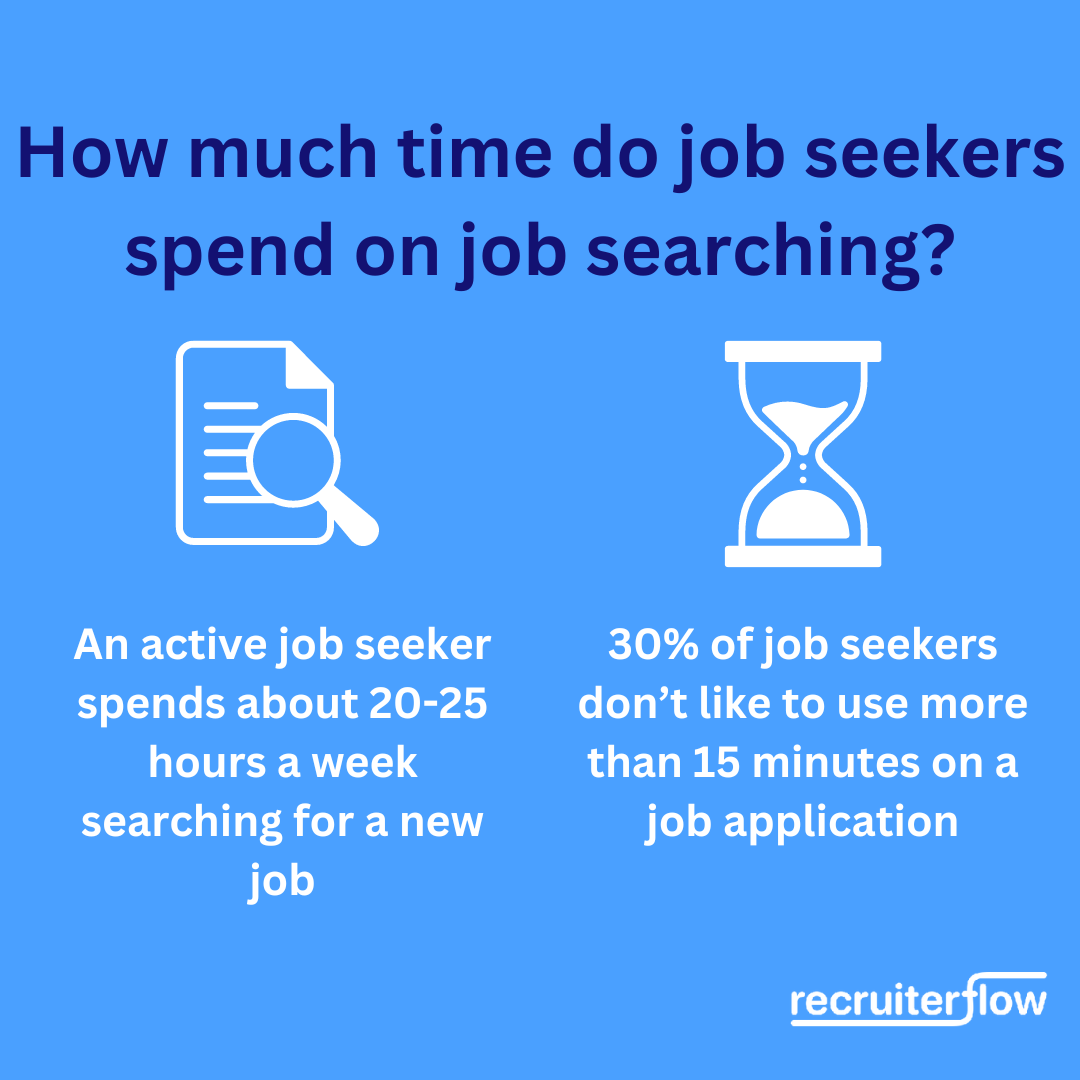
65 Recruitment Statistics to Help You Hire Better in 2025

The recruitment world is undergoing a major shift in 2025. Increased use of generative AI, shift from a candidate-driven market to an employer-driven market, hiring freeze, layoffs—all this creates a new direction for the recruitment industry.
To be a good recruiter, you must keep up with the latest recruitment statistics. It helps you make informed decisions about your recruitment strategies and streamline your hiring process.
In this article, we’ve compiled a list of 65 recruitment statistics that will offer you a wealth of actionable information to hire smarter, faster, and more effectively than ever before!
General recruitment statistics
The recruiting landscape is getting more and more competitive. Hiring managers face an array of challenges as they build high-performing teams. Here’s how the current recruitment market is shaping:
1. The biggest recruiting challenge for recruiters in 2023 was tight talent pools. Source
2. 90% of hiring managers find it difficult to source skilled candidates. Source
3. 52% of recruiters have been facing the challenge of hiring the top choices before their competitors. Source

4. The average cost per hire is approximately $4700. Source
5. It takes a cost of 3-4 times a position’s salary to hire a new resource. Source
Candidate experience recruitment statistics
Candidate experience encompasses every interaction a potential hire has with your company—from the initial job search to the final offer stage and beyond.
But why does candidate experience matter and how does it shape your reputation? Let’s find out.
6. 60% of job seekers do not finish an application process due to its length or complexity. Source
7. 78% of recruiters feel they’re doing a good job of communicating with candidates and setting the expectations upfront. Source
8. 34% of candidates from a survey reported not hearing back from the recruiter in over 60 days and only 7% were notified of not getting the job. Source

9. 55% of candidates believe it should take them 1-2 weeks to go from the first interview to being offered the job letter. Source
10. On average, it takes about 23 days for an interview process to finish. Source
11. Companies investing in candidate experience have seen a 70% improvement in the quality of new hires. Source
Online and social media recruiting statistics
Platforms like LinkedIn, Facebook, Twitter, and Instagram are some essential channels for sourcing and attracting candidates. Think of the ways you can expand your network, build a strong employer brand, and connect with top talent on these platforms!
Let’s uncover how social media recruiting has shaped recruiting today and how job seekers see it.
12. 73% of job seekers aged 18-34 reported to have found their recent job via social media. Source
13. 26 of job seekers are influenced by diversity, equity, and inclusion messages employers post on their social media. Source
14. 57% of job seekers use social media for job hunting. Source
15. 84% of organizations use social media actively for recruiting talents. Source
16. 70% of hiring managers have had success hiring through social media. Source
17. 54% of companies have rejected a candidate based on what they see on their social media. Source
18. 75% of job searches inform their career decision based on LinkedIn. Source
Job search statistics
Job seekers today value learning opportunities, flexible working, and complete transparency in the hiring process. More importantly, they like their potential employers to speed things up in the recruiting process.
Here are some trending data on the expectations of job seekers in the current market scenario.

19. 37% of US candidates are actually passive candidates interested in a new job. Source
20. 50% of candidates apply for jobs from job sites. Source
21. An active job seeker spends about 20-25 hours a week searching for a new job. Source
22. 90% of survey respondents admitted that salary is the most important factor influencing job choice, followed by job responsibilities. Source
23. About 50% of job seekers find the lack of salary transparency frustrating. Source
24. Nearly 30% of job seekers don’t like to spend more than 15 minutes on a job application, those aged 25 to 34 appear to be the most impatient ones! Source
25. About 73% of US employees had planned to start freelancing in 2023. Source
ATS statistics

An applicant tracking system (ATS) automates the recruitment workflow—from job posting and candidate sourcing to resume parsing and applicant screening. It streamlines your recruitment process and expedites your hiring process, so you can focus on hiring better candidates and not on redundant tasks.
Here are some ATS statistics that show the impact of this robust recruitment software and why you should invest in it.
26. About 97.4% of the Fortune 500 companies i.e. 487 companies out of 500 use an ATS. Source
27. The Applicant Tracking System (ATS) Market is projected to reach USD 3.2 Billion by the year 2026. Source
28. The global ATS market is expected to grow at a CAGR of 9.70 % from 2023 to 2035. Source
29. Around 67% of large companies are using an ATS in their process, while only 35% of small businesses rely on it. Source
30. 78% of companies say ATS has made their hiring process easier than ever! source
31. Companies that use an ATS in their hiring process get 2-3 times better results in terms of quality of hire, time to hire, and employee retention. Source
32. ATS innovations such as conversational ATS can accommodate high-volume hiring with chat and text-driven automation and can automate over 90% of the hiring process. Source
33. Only 3% of companies are using all the features and functionalities of their ATS. Source
34. One in two companies would like their ATS to have more features. Source
35. One in five companies is looking to replace their current ATS. Source
Diversity-related recruiting statistics
Diverse recruiting allows you to attract and hire candidates from a wide range of backgrounds, experiences, and perspectives. The goal is to create an inclusive environment where all employees feel valued, respected, and empowered.
Let’s see how diversity impacts the recruiting landscape.
36. 76% of job seekers see diversity as an important factor in considering a job application. Source
37. Businesses that prioritize diversity in their hiring are 25% more likely to outperform their peers. Source
38. 1 in 4 C-suite leaders is a woman, and only 1 in 20 is a woman of color. Source
39. 80% of candidates want to work with companies that value DEI issues. Source
40. Only 6.6% of Fortune 500 companies have women CEOs. Source
AI in Recruiting Statistics
AI uses data to identify patterns, trends, and insights from your recruitment data and augment human-like thinking capabilities. If you’re still wondering if investing in AI recruiting is the right decision for you, here are some interesting recruitment statistics for you!
41. 14% more recruiters added AI skills to their LinkedIn profile, as of 2023. Source
42. 27% of talent professionals are exploring GenAI in their day-to-day recruiting tasks. Source
43. Job seekers who are using AI-boosted resumes have 8% more chances of getting hired. Source
44. Among all the AI tools used in North America, chatbots and intelligent messaging were the most used. Source
45. 85% of recruiters think AI is useful. Source
46. 79% of recruiters believe AI will soon be competent enough to make hiring and firing decisions. Source
47. 44% of recruiters believe AI will save them time. Source
48. 35% of recruiters are concerned about AI overlooking unique and unconventional talents. Source
49. 68% of recruiters expect AI to remove unconscious bias from hiring. Source
50. The main reason 44% of recruiters started using AI is to save time. Source
51. 96% of recruiters think AI will be helpful with their jobs and make them easier, while 60% fear it’s going to replace them. Source
Remote recruiting statistics
Remote recruiting has become a norm since the pandemic. While employees find remote work a better solution to productivity, recruiters struggle to find the best talents.
Here’s how remote recruiting has shaped over the years.
52. The major challenges when hiring remotely are to assess a candidate’s emotional intelligence, soft skills, and team culture fit. Source
53. For US-based companies that were operating remotely, the recruitment process was fairly easy. Source
54. Remote hiring has enabled Meta to access a diverse candidate pool, which resulted in 46.7% of their workforce comprising underrepresented employees and 75% spanning from various locations in 2022. Source
55. 60% of job seekers hoped to find remote work in 2022, while 20% only wanted remote work and nothing else. Source
56. 56% of professionals know people who are soon to quit their jobs due to the “return to office” mandate. Source
57. 70% of US candidates still prefer in-person interviews, despite an increase in interest for remote work in the last few years. Source
Also, check our blog on How to start a recruitment agency remotely.
Staffing agency statistics
The year 2023 was the year of economic slowdown for most staffing agencies. And yet, the market investors are anticipating good growth in the coming quarters. Let’s uncover some intriguing recruitment statistics on the current state of staffing agencies.

58. US staffing agencies saw a median 5% y/y decrease in revenue in February, in line with the 5% decrease in December 2023. SIA staffing industry pulse survey report
59. The staffing industry revenue in 2023 totaled around 593 billion U.S. dollars. Source
60. American staffing companies hire over 14.5 million temporary and contract employees during a year. Source
61. In 2025, experts anticipate the US temporary staffing market to reach a value of $185.6 billion. Source
62. Major staffing industries saw a 20% decrease in their net incomes in Q4 2023. Staffing industry analysis blueprint by Recruiterflow
63. Staffing firms saw an uptick of almost 13% in their market cap in Q4 2023. Staffing industry analysis blueprint by Recruiterflow
64. 20% of staffing employees choose temporary/contract work citing schedule flexibility as a reason. Source
65. The revenue of major staffing firms continues to decline at an accelerated pace—from -0.11% q-o-q in Q4 2022 to -3.36% in Q3 2023. However, in Q4 2023, despite a decrease in revenue in comparison to Q3 2023, the slowdown rate improved by 7%. Staffing industry analysis blueprint by Recruiterflow
Make informed decisions using insights from recruitment statistics
Recruitment is continually evolving shaped by technological advancements, shifting demographics, and changing workforce dynamics. By understanding the current recruitment trends, challenges, and opportunities in the recruitment process, you can reallocate your resources for better results.
Happy recruiting!
Book a demo and see how Recruiterflow can transform your hiring.
Recruitment




